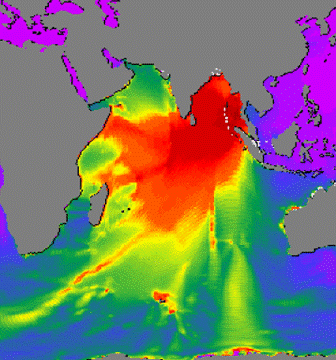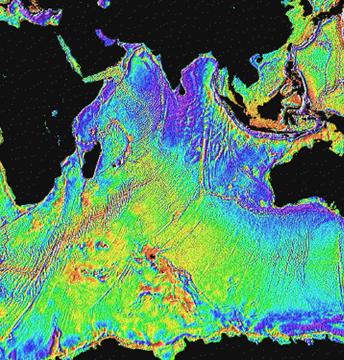Indian Ocean Tsunami
Calculating Tsunami Run-Up Height
Sylvia Wijaya
CEE 514 – Coastal Engineering
Analysis
There are many factors affecting the propagation of tsunami. In the picture below, we can see that there is a certain pattern of which the tsunami waves travel. There are many questions raised up such as: why different places have different wave run-up, why tsunami wave seems to disappears after propagation but then the wave rise again when it hits the land, and why two places with relatively same distance from epicenter could result in different wave run-up, and why Somalia which is relatively far from the epicenter is in worse condition than Bangladesh which is relatively close to the epicenter.


Figure 10: (Left) Tsunami wave height in different areas. (Red ~ 80 ft, Blue ~ 0 ft), (Right) Basin Topography of Indian Ocean
Among different factors, I find out that the most important factor in predicting the wave run-up is the slope of the basin. The above picture on the right side is the picture of basin topography of Indian Ocean. From the pictures, the basin topography pattern fits pretty well with the wave height pattern. Therefore we can relate the tsunami wave height in different places with the basin topography characteristics. In general, the tsunami will propagate toward more gradual basins. The more gradual the depth transition is, the more significant the wave height is. My purpose in this project is to calculate the wave run-up at the coast, and with the analysis above, I will relate the effect of the slope at the coast to the wave run-up. For this goal, I will use energy conservation theory to obtain wave run-up formula.
Run-Up Height: the height above the reference level, which the water reaches as the tsunami arrives.

Figure 11: The definition of wave run-up height.
Using Energy Conservation:

Integrating potential energy and kinetic energy at the offshore:

Integrating potential energy and kinetic energy at the nearshore:

Substituting both offshore and nearshore potential and kinetic energy into energy conservation formula:

Relationships between wave run-up and coastline slope:

where: Hr = wave run-up height
L = the extent of which tsunami wave travels inland
α = slope angle